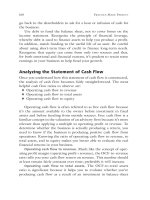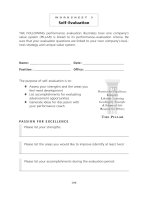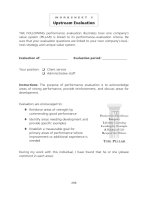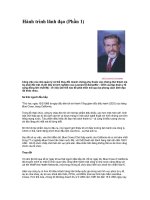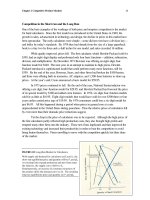Tài liệu Practice Made Perfect 7 ppt
Bạn đang xem bản rút gọn của tài liệu. Xem và tải ngay bản đầy đủ của tài liệu tại đây (131.45 KB, 10 trang )
This page is intentionally blank
A
S ADVISERS STRIVE to build closer relationships with their clients
and improve the quality of their services, more firms have begun
to formalize their approach to gathering feedback from clients. For
advisory firms developing and refining their business strategy, we’ve
found client surveys to be invaluable because they help the firms get
in tune with their market and with the services the optimal client
looks to them to provide.
For many years, we were skeptical about the value of client surveys
because we did not believe that eliciting satisfaction scores from cli-
ents would garner anything particularly insightful. It seemed unlike-
ly that clients who disliked an adviser would respond, and those that
had “warm and fuzzy” feelings about their advisers would probably
sugarcoat their responses. The validity and real value of the client
surveys was always suspect to us.
Then we found a survey process that not only allowed clients to
evaluate their advisers in a meaningful way but also could be used
as a tool to allow clients to identify their needs and preferences in
adviser-client communication and the planning areas they wish
advisers would address with them. Advisers who participated in such
surveys were generally surprised by the results because in many cases
they thought they had broached these subjects with their clients, but
the overtures had not always registered. Ross Levin, of Accredited
Investors, for example, tested a tool developed by Advisor Impact
of Toronto. “Our results were positive, and yet some of the specific
points were surprising,” he says. “Some clients wanted to meet less
39
KNOWING
YOUR
CLIENTS
The Value of Surveys
3.
40 PRACTICE MADE PERFECT
often than we currently do. Also, some clients wanted more general
communication. After the survey, we worked with our staff to deter-
mine optimum meeting schedules. We also now send out a regular
e-mail update on our views on the market, interest rates, and other
relevant data.”
Hear No Evil
Despite the potential for such enhancements, only about a third of
advisers have surveyed their clients in the last twelve months, accord-
ing to research by Advisor Impact. And although some advisers point
to a lack of time or expertise as the primary obstacles to conducting
a survey, the fear factor tends to top the list of self-imposed barriers.
Some advisers are afraid to hear what their clients will say—a concern
present in both good and bad markets. But research doesn’t support
the fear factor. Theoretically, in a market as competitive as financial
services, existing customers on average tend to be highly satisfied
or else they would leave. Our research confirms that argument in
practical terms.
As part of a joint venture between Advisor Impact and Moss
Adams LLP, we surveyed more than ten thousand clients on behalf
of financial advisers across North America. No adviser got an over-
all satisfaction rating lower than four out of a top score of five. Yet
that process also revealed that between 2 percent and 10 percent
of clients are, in fact, at risk of defecting. This is a very disturb-
ing percentage considering how many advisers believe their clients
are perfectly content. Surveys done in Canada, the United States,
and Australia all have identified “managing client expectations” as
among the top sources of anxiety for financial advisers. With so
many things competing for your time, it’s helpful to find efficient
tools that allow you to probe these expectations. What’s more, in
an environment where competition is intensifying and the offer-
ings from banks, CPAs, law firms, and other wealth managers are
becoming more responsive, client surveys are a vital intelligence-
gathering tool. Your practice may not be geared toward “cross
selling” in the traditional sense of a bank or brokerage firm, but
retaining clients is a form of selling that every professional adviser
KNOWING YOUR CLIENTS: THE VALUE OF SURVEYS 41
must be conscious of. Clearly, a client survey can provide insight
beyond what can be gained from regular client contact, because it
allows the person to respond without being confronted or having
to look the adviser in the eye.
For most advisory firms, more than 85 percent of revenue comes
from existing clients. So it’s ironic that advisers tend to spend more
money on new business development than they do on harvesting
and maintaining the relationships they already have. In fact, even
compensation plans are geared toward getting more clients rather
than retaining or deepening the relationship or share of wallet with
current clients.
Client surveys can improve overall client profitability. Properly
structured, surveys improve the efficiency, loyalty, time management,
and productivity of your professional staff. Systematically uncovering
issues through a survey process not only helps you manage costs bet-
ter; it also makes your practice better able to attract assets, drive rev-
enue, introduce value-added services, and elicit referrals from your
client base (see Figure 3.1).
A comprehensive study published in the Harvard Business
Review
1
in 2002 reached some strong conclusions in favor of survey-
FIGURE 3.1 Improving Client Profitability
Efficiency Assets under
management
Referrals
Product/service
RevenueLoyalty
Time
Direct costs
Costs Revenue
CLIENT
PROFITABILITY
Source: © Advisor Impact
42 PRACTICE MADE PERFECT
ing clients. The study found that clients surveyed for a large financial
institution were more than three times as likely to have opened new
accounts, half as likely to have defected, and were more profitable for
the firm than clients who were not surveyed. The study noted that
these results, which peaked after three months, extended for up to
twelve months after the survey.
At least two factors explain these results. First, surveys remind
clients that they appreciate the services you offer. In general, cli-
ents are unlikely to have spontaneous positive thoughts about you
unless reminded or asked explicitly. Second, by asking clients ques-
tions about specific services, you increase their awareness of those
offerings.
A properly performed client survey will uncover the following:
! Satisfaction
! Expectations
! Preferences
! Interests
! Referral propensity
! Your share of wallet
! Client profile
Such insights enhance your value to clients and their value to
you.
How to Elicit Constructive Responses
There are three ways to elicit responses from clients: take an ad hoc
approach and ask them for comments at the end of a meeting, con-
duct a telephone survey, or conduct a written survey. To decide which
route to take, you’ll need to weigh the costs of the program against
the depth of information you’ll receive and the extent to which
answers are provided honestly. In general, written surveys tend to be
the best option. Although more expensive, they let you ask a large
number of questions, give clients time to respond thoughtfully, and
offer clients the option of anonymity.
It can be difficult to directly compare the cost of outsourcing
the survey process to the cost of doing it in-house, but you’ll typi-
KNOWING YOUR CLIENTS: THE VALUE OF SURVEYS 43
cally spend more time and money if you conduct the survey on your
own. To create a professional survey instrument with well-designed
questions that will yield the insights you seek, you’ll likely need to
hire a writer and possibly a graphic designer to prepare the question-
naire and then pay for printing and mailing the survey, entering the
response data, and analyzing the results. Advisor Impact’s Client
Audit process, for example, would cost around $2,000 plus out-
bound postage to survey two hundred households, with an expected
30 percent response rate, but a similar effort done in-house could
cost a planner more than twice that amount and likely yield less
meaningful results.
Using professional organizations such as Dalbar, Advisor Impact,
or local marketing firms tends to enhance the survey process. It’s like
an individual who prefers to make planning, investment, and risk-
management decisions without seeking qualified advice. She can do
it cheaper, but can she do it better? We find that advisers who try to
do surveys themselves either do not get them finished or have dif-
ficulty interpreting the results. Worse yet, they skew the results by
asking the wrong questions, or they skew the wording of the ques-
tions to get the answers they want to hear.
For the do-it-yourselfer, the first challenge is identifying which
questions to ask clients. To start, think beyond “satisfaction.”
A properly structured survey helps you uncover client expectations,
identify cross-selling and consolidation opportunities, pinpoint
those clients who are willing to provide referrals, and gather valu-
able intelligence about any current or planned communications or
activities. For the best results, be sure to ask questions in five spe-
cific categories:
1. Focus on service satisfaction, both generally and specifically.
2. Probe client expectations regarding contact level.
3. Assess interest in learning about different products and services.
4. Determine client preferences about how you communicate.
5. Ask for profile information to help you populate your data-
base.
Even if you cover all of your bases, not all questions are equally
effective. Good questions provide you with specific and targeted
44 PRACTICE MADE PERFECT
information. Bad questions are vague, are difficult to understand, or
lead to client responses that are difficult to interpret. (See Figure 3.2
for examples of good questions in each category.) For every question
in a survey, you should know what you’ll do with the results. If you
do not control client statements at your firm, for example, do not ask
about satisfaction with client statements on the survey.
If you do go it alone, the process of surveying clients can be oner-
ous but rewarding. Given the investment of time and money, make
sure you fully exploit the results. You can get the biggest bang for
your buck by
FIGURE 3.2 What to Ask and How to Ask It
Sample Question Tips and Comments
Satisfaction My calls are returned Be specific about the
promptly (on a five-point elements of client service
scale from “completely rather than asking vague
agree“ to “completely questions about service
disagree”). in general.
Expectations How many times do you Gather quantitative data
expect to meet in a 12- when possible.
month period to review
your financial plan?
Interests Which of the following Get clients thinking about
are you interested in the services you provide;
learning more about? don’t leave too many
(Provide list of services.) open-ended questions.
Preferences Do you think it’s important Don’t just ask how you
for your financial adviser are doing; find out what
to provide educational is most important to your
opportunities? clients.
Profile What is your e-mail Gather better information
address? to populate your database.
KNOWING YOUR CLIENTS: THE VALUE OF SURVEYS 45
! sending a follow-up letter to all clients, highlighting positive
feedback and identifying any changes you plan to make as a
result of the survey
! surveying clients every eighteen months and tracking your
progress
! summarizing your results for centers of influence and prospects
Testimonials are helpful, but research data are seen as more
objective.
In the spirit of full disclosure, we mention here that Moss Adams
LLP adopted the Client Audit process for its advisory-firm clients
after evaluating many options. By using a proven survey process—in
this case, one developed by Advisor Impact—we’ve consistently been
better able to develop insight into how our advisory-firm clients
should be thinking strategically about their businesses.
The Client Audit process is a structured approach that provides
a customized solution. The survey form is customized and then
provided to the adviser for mailing to clients, and the reports are
returned to a central processing center. There, the data are evaluated
and interpreted and action steps are developed for the adviser (see
Figure 3.3 on the following page).
In addition to the insight, what’s compelling about this process is
the action plan that comes out of the survey. So many times, when
surveys are performed, clients are often left wondering what the pur-
pose or result was. So regardless of whether you do it on your own
or in concert with a professional survey firm, you’ll want to translate
the survey results into an action step or the process will be wasted,
along with the money it cost to do it.
“Since surveying our clients, we’ve developed a sharper pic-
ture of our strengths,” says Jennifer Hatch, an adviser with
Christopher Street Financial in New York. “We understand our
weaknesses and can respond before our clients decide to bail.
For example, we were able to understand the level of service that
each of our advisers was providing and discovered that [it] varied
drastically. As a result, we now set an explicit service standard for
everyone in the company.”
46 PRACTICE MADE PERFECT
Proceed with Caution
You need to be aware of some restrictions regarding how to conduct
surveys and how to use the information gathered. The American
Marketing Association has a clear code of ethics regarding marketing
research, including satisfaction surveys, and that code was written
into law. You cannot sell services to clients under the guise of con-
ducting research. Therefore, if you plan to ask questions about client
needs and then use that information to follow up with them, make
your intentions clear in the cover letter and reiterate that the client
may respond anonymously.
FIGURE 3.3 The Report
Your
Client
Audit
Report
Action Plan
✓
Follow-up templates for clients, centers of influence,
and prospects
!
Suggested client marketing campaigns
!
Assessment and identification of assets at risk
✓
Recommended changes to service structure
The Big Picture
✓
Overview of all responses, including:
!
Key marketing opportunities
!
Top client issues
✓
Client expectations regarding contact and education
Client Opportunity Report
✓
Client-by-client overview of key opportunities
!
Cross selling
!
Consolidation
!
Referrals
!
Other marketing opportunities
✓
Follow-up lists for key marketing opportunities
Source: © Advisor Impact
KNOWING YOUR CLIENTS: THE VALUE OF SURVEYS 47
Overall, the best way to make a client survey successful is to
! keep it short
! assess importance and performance
! ask actionable questions
! include a deadline
! provide an incentive
! make including client’s name optional
! code the surveys (to maintain anonymity)
! include an open-ended question
! make it easy to respond
Client Surveys and the Bottom Line
Many advisers consider client surveys a way to let clients know that
they care. They do, in fact, demonstrate a real commitment to client
relationships (provided you follow up on the results), but they can
do much more.
Our premise throughout this book is that the work of advisers
profoundly affects the lives of their clients. An adviser’s work gives
peace of mind, clears the road to financial independence, and helps
individuals and families to manage their risks. Yet many advisers do
not have the confidence to ask for fair compensation for the value
they provide.
A hidden benefit of the client-survey process is that it allows
you to listen and respond constructively to clients in ways that will
enhance your value. The survey can provide the psychic gratification
of anticipating client needs. But it can also further demonstrate your
value to your clients and justify your fees in a way that helps you to
be profitable and fairly rewarded for what you provide.
Note
1. Paul M. Kholakia and Vicki G. Morwitz, “How Surveys Influence
Customers,” Harvard Business Review (2002): 18–19.
